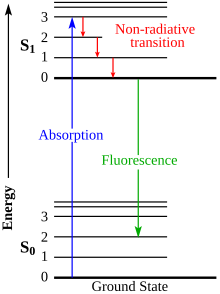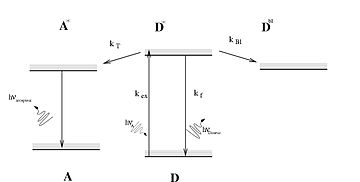
| This article needs additional citations for verification. Please help improve this article by adding citations to reliable sources. Unsourced material may be challenged and removed. Find sources: "Jablonski diagram" – news · newspapers · books · scholar · JSTOR (July 2023) (Learn how and when to remove this message) |
In molecular spectroscopy, a Jablonski diagram is a diagram that illustrates the electronic states and often the vibrational levels of a molecule, and also the transitions between them. The states are arranged vertically by energy and grouped horizontally by spin multiplicity. Nonradiative transitions are indicated by squiggly arrows and radiative transitions by straight arrows. The vibrational ground states of each electronic state are indicated with thick lines, the higher vibrational states with thinner lines. The diagram is named after the Polish physicist Aleksander Jabłoński who first proposed it in 1933.
Transitions

When a molecule absorbs a photon, the photon energy is converted and increases the molecule's internal energy level. Likewise, when an excited molecule releases energy, it can do so in the form of a photon. Depending on the energy of the photon, this could correspond to a change in vibrational, electronic, or rotational energy levels. The changes between these levels are called "transitions" and are plotted on the Jablonski diagram.
Radiative transitions involve either the absorption or emission of a photon. As mentioned above, these transitions are denoted with solid arrows with their tails at the initial energy level and their tips at the final energy level.
Nonradiative transitions arise through several different mechanisms, all differently labeled in the diagram. Relaxation of the excited state to its lowest vibrational level is called vibrational relaxation. This process involves the dissipation of energy from the molecule to its surroundings, and thus it cannot occur for isolated molecules.
A second type of nonradiative transition is internal conversion (IC), which occurs when a vibrational state of an electronically excited state can couple to a vibrational state of a lower electronic state. The molecule could then subsequently relax further through vibrational relaxation.
A third type is intersystem crossing (ISC); this is a transition to a state with a different spin multiplicity. In molecules with large spin-orbit coupling, intersystem crossing is much more important than in molecules that exhibit only small spin-orbit coupling. ISC can be followed by phosphorescence.

See also
- Franck–Condon principle
- Grotrian diagram (for atoms)
References
- “Jablonski Diagram.” 2006. In IUPAC Compendium of Chemical Terminoloy, 3rd ed. International Union of Pure and Applied Chemistry. https://doi.org/10.1351/goldbook.J03360.
- P., Atkins, P., de Paula, J. Atkins' Physical Chemistry, 8th edition (2006), page 494, Oxford University Press. ISBN 0-7167-8759-8
- Jabłoński, Aleksander "Efficiency of Anti-Stokes Fluorescence in Dyes" Nature 1933, volume 131, pp. 839-840.doi:10.1038/131839b0
- Harris, D. C. Lucy, C. A. Quantitative Chemical Analysis, Tenth Edition (2020), pp 457-458, W.H. Freeman and Co.
External links
- Florida State University: Jablonski diagram primer
- Consequences of Light Absorption – The Jablonski Diagram
This molecular physics–related article is a stub. You can help Misplaced Pages by expanding it. |
This spectroscopy-related article is a stub. You can help Misplaced Pages by expanding it. |